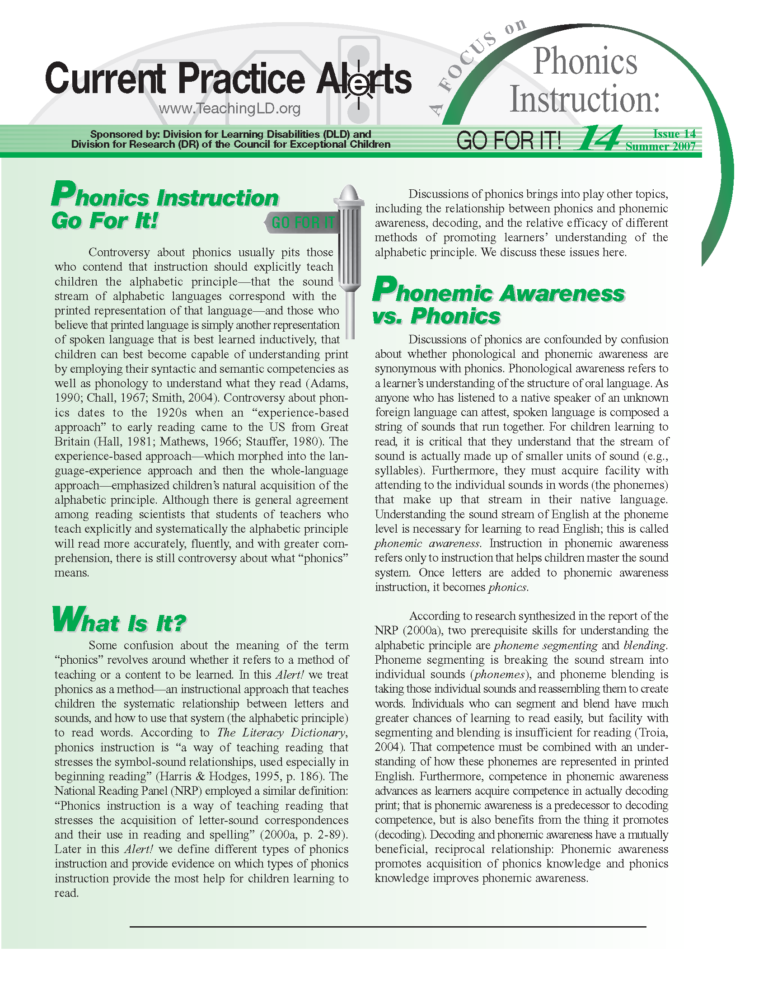Tagged as: Go for it
Peer Assisted Learning Strategies
Elizabeth Hughes, The Pennsylvania State University & Emily Solari, University of Virginia
Issue 29
Peer-Assisted Learning Strategies (PALS) refers to a reciprocal peer tutoring routine intended to serve as supplemental instruction to support strong core curriculum. Guided by classroom teachers, PALS systematically incorporates cooperative learning, highly structured peer interactions, reinforcement of academic behaviors, and multiple opportunities to practice.
ReadingThe Alert Series
TeachingLD
Alert Issue 1, Spring 1999
This introduction to the Alert series summarizes the goal of the joint initiative and outlines the format used to examine practices.
UncategorizedDirect Instruction
Sara Tarver, University of Wisconsin
Alert Issue 2, Summer 1999
Direct Instruction (DI) is an approach to teacher-directed explicit instruction distinguished from other approaches by its emphasis on both instruction and curriculum design. The goal of DI is to accelerate student learning by maximizing efficiency in the design and delivery of instruction. Our review of the research on DI indicates that it is an effective […]
Content AreasFormative Evaluation
Christine Espin, Jongho Shin, & Todd Busch, University of Minnesota
Alert Issue 3, Spring 2000
Formative evaluation is the ongoing collection of information in order to evaluate the effectiveness of instructional implementations and to determine whether adaptations to the instruction are necessary. There are many specific approaches to formative evaluation, including Curriculum Based Assessment (CBA), Curriculum-Based Measurement (CBM), and Portfolio and Performance Assessment (PA). Of these approaches, CBA and PA […]
AssessmentMnemonic Instruction
Rick Brigham & Michelle Brigham, University of Virginia
Alert Issue 5, Summer 2001
Mnemonic instruction combines presentation of unfamiliar information with explicit strategies for recall. Most mnemonic strategies rely on both verbal and imagery components to support recall. Research suggests large gains from mnemonic instruction on criterion-referenced tests, but evidence of gains on norm-referenced tests is less clear.
Content Areas ReadingClass-wide Peer Tutoring
Larry Maheady, Gregory Harper, Barbara Mallette, SUNY Fredonia
Alert Issue 8, Spring 2003
Class-wide peer tutoring refers to a class of instructional strategies in which students are taught by peers who are trained and supervised by classroom teachers (Greenwood, Maheady, & Delquadri, 2002). The oldest and most widely researched class-wide peer tutoring (CWPT) approach was developed and refined at the Juniper Gardens Children’s Project in Kansas City, over […]
Content AreasPhonological Awareness
Gary A. Troia, University of Washington
Alert Issue 10, Summer 2004
Phonological awareness is an explicit understanding that spoken language comprises discrete units ranging from entire words and syllables to smaller intrasyllabic units of onsets, rimes, and phonemes. Phonemic awareness is the deepest level of phonological awareness and the most crucial to success in reading and spelling. Evidence indicates that deliberate, systematic instruction in phonological awareness […]
ReadingReading Comprehension Instruction
Rick Brigham, Sheri Berkeley, Pamela Simpkins, and Michele Brigham, George Mason University
Alert Issue 12, Spring 2007
Comprehension strategies are specific, learned procedures that foster active, competent, self-regulated, and intentional reading. Comprehension strategy instruction is appropriate for individuals who consistently fail to develop a coherent understanding of material that is read. One such strategy is self-questioning during reading. The self-questioning approaches discussed in this Alert improved comprehension in research studies.
ReadingGraphic Organizers
Ed Ellis and Pamela Howard, University of Alabama
Alert Issue 13, Spring 2007
Graphic organizers (GOs) are visual devices that employ lines, circles, and boxes to organize information. These images serve as visual cues designed to facilitate communication and/or understanding of information. There is ample research that documents improvements in reading comprehension, process writing skills, thinking skills, and learning of content-area material when graphic organizers are used.
Content Areas Mathematics Reading
Phonics Instruction
Paige Pullen and John WillsLloyd, University of Virginia
Alert Issue 14, Spring 2008
Phonics is an instructional approach that teaches children the systematic relationship between letters and sounds, and how to use that system (the alphabetic principle) to read words. Research indicates that phonics approaches in beginning reading produce better outcomes in decoding, comprehension, and collateral skills (e.g., spelling) than do alternative methods.
Reading